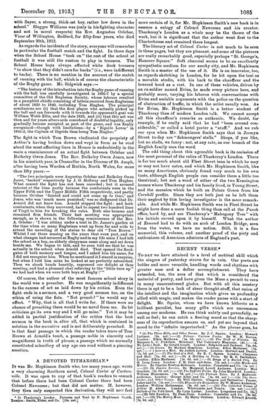A DEVOTED TITMARSHIAN.* IT was Mr. Hopkinson Smith who, too
many years ago. wrote a very charming Southern novel, Colonel Carter of Carters-
• ville. It was open to any of that book's readers to remark that before there had been Colonel Carter there had been Colonel Newcome ; but that did not matter. If, however, they- then only. suspected this derivation, they will now feel • In Thackeray'a London. Pictures and. Text by F. Hopkinscao Smith. -lowd,on : -Smith, Elder, and Co. Else. tiet.3 . .
more certain of it, for Mr. Hopkinson Smith's new book is in essence a eulogy of Colonel Newcome and his creator. Thackeray's London as a whole may be the theme of the work, but it is significant that the author went first to the Charterhouse and remained there longest.
The literary art of Colonel Carter is not much to be seen in these pages, but they are pleasant, and some of the pictures are really remarkably good, especially perhaps " St. George's, Hanover Square." Soft charcoal seems to be an excellently sympathetic medium for our smoky city, and Mr. Hopkinson Smith is a master of the use of it. He is an innovator, too, as regards sketching in London, for he bit upon the taxi as a movable studio, with his back to the chauffeur and the lowered hood as a rest. In one of these vehicles, driven by an ex-soldier named Evins, he made every picture here, and probably more, varying his labours with conversations with Evins and amiable arguments with the police on the question of obstruction of traffic, in which the artist usually won. As for Evins, Mr. Hopkinson Smith is a better student of Thackeray than of modern London talk. We cannot accept all this chauffeur's remarks as authentic. We doubt, fur example, if he really said that he had " been around con- siderable," or called a hotel porter a "stuff." And we rub our eyes when Mr. Hopkinson Smith says that in Jermyn Street to-day are " fishmongers' stalls." Shops, if you like, but no stalls, we fancy : not, at any rate, as our branch of the English family uses the word.
The odd thing about this agreeable book is its omission of the most personal of the relics of Thackeray's London. There is far too much about old Fleet Street inns in which he may or may not have eaten, and which Mr. Hopkinson Smith, like so many Americans, obviously found very much to his own taste, although English people can consider them a little too theatrical; but not a word of either of the two Kensington houses where Thackeray and his family lived, in Young Street, and the mansion which he built on Palace Green from his Conchal profits. Since they are both just as he left them their neglect by this loving investigator is the more remark. able. And while Mr. Hopkinson Smith was in Fleet Street be might have done a more foolish thing than call at the Punch office, hard by, and see Thackeray's "Mahogany Tree" with his initials carved upon it by himself. What the author of Esmond bad to do with an arch of London Bridge, seen from the water, we have no notion. Still, it is a fine memorial, this volume, and another proof of the piety and enthusiasm of American admirers of England's past,










































 Previous page
Previous page